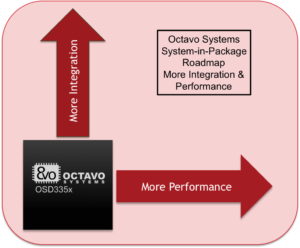
Greg Sheridan
Marketing Manager
Posted on April, 11, 2018
Categories
Recent Posts
- Octavo Systems Unveils the OSD32MP2 Series: Revolutionizing System Design in the Electronics Industry April 9, 2024
- Securing the Future: The Integral Role of SiP Technology in Thwarting Physical Attack Vectors in Embedded Systems March 12, 2024
- Developing Secure Embedded Systems: Best Practices and Strategies March 12, 2024
- Heterogeneous Integration (HI) and System-in-Package (SiP) Technology: A Comprehensive Overview February 20, 2024
- Understanding The Differences Between System-on-Chip (SoC), Package-on-Package (PoP), System-on-Module (SoM), and System-in-Package (SiP) January 17, 2024
Octavo Systems Product Strategy Look Ahead
Our engineering team has been hard at work developing some new products that we will be announcing soon. In the meantime I wanted to take some time to explain our product development philosophy and how that influences the products that we currently have and our Roadmap products.
System Integration Company
At our heart, Octavo Systems is a Systems Integration company. We utilize System-In-Package technology to create modular building blocks that help system designers do their jobs. Our products abstract away tedious and complex tasks the designer is forced to spend time on but don’t really add any value to the end system.
Take the DDR3 in our OSD335x device. Routing DDR is a notoriously difficult and time-consuming task that at the end of the day doesn’t differentiate your product from the next one. The OSD335x integrates the DDR3 and takes care of the routing for you. This means you don’t have to waste your time doing something that just needs to work. Designing with the OSD335x allows you to spend more time on the features that make your product unique.
This is the overarching principal behind our products. We integrate the tedious time-consuming parts of system design so you can focus on what differentiates your product.
Where to Next?
With that as our driving principal where do we go from the OSD335x? When we look at our product roadmap we see two axes we can travel along. The first is further integration and the other is to expand to other processor platforms.

More Integration
The first, somewhat obvious, path is to integrate our solutions further. Further integration can mean doing more in the same package or doing the same thing in a smaller package. The OSD335x-SM is an example of how we are already moving down this path. Not only did we shrink the package by 40% but we also added EEPROM to the components already integrated.
However, there is still more we can do. While integrating the DDR and power management with the processor into a single package takes care of a lot of the components common to most systems, there are still things that every system requires. These are elements like clocks and Non-Volatile Boot memory. Integrating these would give you a completely self-contained Linux Processing Unit that you can easily drop into any system. No more having to worry about sourcing EMMC or dealing with crystals. Just drop this completely integrated device in and move on.
Then beyond this there are some common system blocks required by many systems that are just tedious to deal with. These consist of different communication interfaces and other analog devices. Integrating these types of components will simplify the designs further and significantly reduce the complexity of manufacturing and sourcing components.
We are constantly talking to customers to understand what some of their biggest challenges are when doing system design. We use this feedback to drive our roadmap. We are developing devices that are more self-contained requiring even less external components. The end goal is to make the designers life as simple as possible, enabling them to push the boundaries of their application, and not worry about every tiny component.
Processor Platforms
The OSD335x is built around a 1GHz ARM Cortex-A8 processor from Texas Instruments. This is a great general-purpose processor with a superior power to performance ratio. It is the perfect device for a wide range of applications from consumer goods to large industrial control systems. Its versatility and long life made it the perfect choice to build our first product family around. With the exponential growth of Internet-of-Things, (IoT), we are seeing new applications for the OSD335x each week. However, we do see applications that are good candidates for SiP but not the OSD335x. Some may require significantly more processing power that is only possible with multiple ARM cores. Other applications require less power like what can be found in an ARM M4.
However, M4 type processors don’t require external DDR or complicated supplies most of the time so the value of SiP integration doesn’t really make sense in this space. Higher performance processors on the other hand typically come with higher speed interfaces, wider buses, and more complex power systems. All of which add to the complexity of a design making it harder to leverage this performance in new systems. This class of processor is a perfect candidate for SiP integration.
With that said, we are hard at work expanding the successful formula we have found with the OSD335x to other higher end platforms. We want to bring the same benefits to more applications and enable more designers to harness the power that comes along with these new processors.
Packaging It Up
So where is Octavo going? We are working hard to further simplify embedded systems by integrating more common components into our packages. We are also expanding our technology to encompass more platforms for more applications.
If you have anything you would like to see integrated or new processors to create SiPs around let us know in our forums. We are only successful if we are creating what you need.
We have a lot going on so stay tuned for updates. You can sign up for our mailing list or follow us on Facebook, Twitter, or Linked In.
